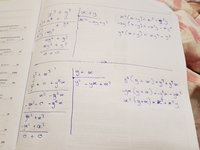Yo guys,
I Just realized whether you divide y by y or x by x the result is still the same.
I tried the other way because I wondered why x divided by x was the only way suggested by the author.
As you know if I dont know all the details i dont feel confortable moving on to the next chapter.
You didn't quite state the problem, but I think you are dividing [MATH]x^3 + y^3[/MATH] by [MATH]x+y[/MATH].
What you discovered, in part, is
symmetry: the polynomial remains the same if you interchange x and y.
But, perhaps more directly connected to what you observe, you can see the same problem from two different perspectives, thinking of either x or y as the "main variable" and the other as a parameter in your division procedure. Since the goal is just to find the missing factor in [MATH]x^3 + y^3=(x+y)(?)[/MATH], it makes no difference which way you see it, so you must get the same result. As someone has said, correct answers don't care how you found them.
This is worth becoming aware of! For one thing, after going through the process a few times of verifying that it doesn't matter which way you do something, you can worry less about choosing the right way. On the other hand, it gives you the right to pause and think about different methods you might use and choose which you think might be easiest or clearest -- and to back off and try another way if you turn out to be wrong.
I think Jomo's comment is more or less about the symmetry; but I wouldn't really call them dummy variables here, as you are given the problem with x and y playing specific roles, and can't change them. It just happens that in this case that has no effect (because of the symmetry).[/MATH]

